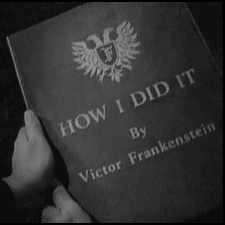
(or rather, by Baylor Johnson)
Creating the music for The Robot Frankenstein took several days work in both the ACTLAB and the Digital Media Lab in the CMA, depending on which was open and what software I needed. I found the Lab in the CMA to sometimes be more useful when I was going from program to program (as I did a lot) because there was just more pixels on the screen, and I could see through the clutter better.
When I decided to tell the story of Frankenstein musically, before all other considerations were made, one other issue came into play: length. In order to not seem like too much of a slacker project, it needed to be longer than about five minutes, but shorter than eight for logistics and because it could lose the audience after awhile. But five to eight minutes is hardly enough time to tell the entire story of Frankenstein. And so, I settled on telling the first section of the story. The piece is, therefore, more like the first movement of a longer piece.
The work largely consisted of my composing the notes themselves in either GarageBand (usually the case) or Logic. The thing about working with GarageBand is that your ultimate goal is to make sure that what you create doesn't sound like it was made with GarageBand. I would then, depending on what kind of filters I wanted to use, take it either into Audacity or Soundtrack Pro. That's where the effects and the mixing would occur.
Also, there are some sampled sounds, as you can imagine, in the piece. The descending bells that signify Victor's descent into madness are an example of a Shepard's paradox, which is sort of the auditory equivalent of an Escher painting: sounds like its going down, but it's actually going up. All of the sound effects for the creation of the monster, and the lightning storm came off the stock server, and the heartbeat at the end came from a piece of music composed by a friend.

